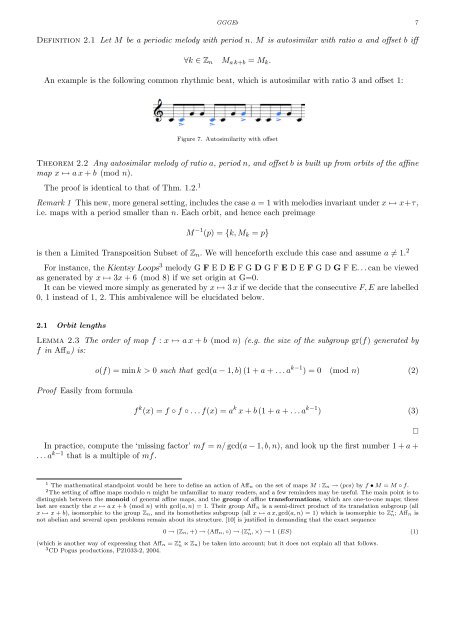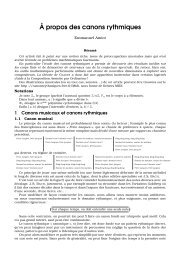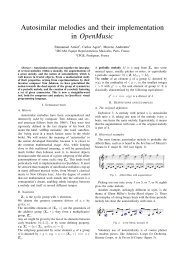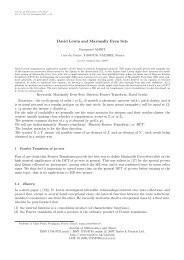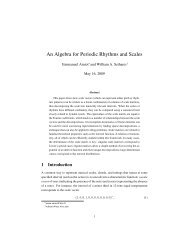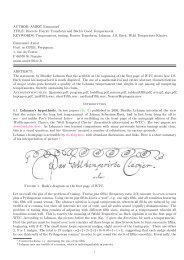Emmanuel Amiot Modèles algébriques et algorithmes pour la ...
Emmanuel Amiot Modèles algébriques et algorithmes pour la ...
Emmanuel Amiot Modèles algébriques et algorithmes pour la ...
You also want an ePaper? Increase the reach of your titles
YUMPU automatically turns print PDFs into web optimized ePapers that Google loves.
GGGE♭ 7<br />
Definition 2.1 L<strong>et</strong> M be a periodic melody with period n. M is autosimi<strong>la</strong>r with ratio a and offs<strong>et</strong> b iff<br />
∀k ∈ Zn Ma k+b = Mk.<br />
An example is the following common rhythmic beat, which is autosimi<strong>la</strong>r with ratio 3 and offs<strong>et</strong> 1:<br />
Figure 7. Autosimi<strong>la</strong>rity with offs<strong>et</strong><br />
Theorem 2.2 Any autosimi<strong>la</strong>r melody of ratio a, period n, and offs<strong>et</strong> b is built up from orbits of the affine<br />
map x ↦→ a x + b (mod n).<br />
The proof is identical to that of Thm. 1.2. 1<br />
Remark 1 This new, more general s<strong>et</strong>ting, includes the case a = 1 with melodies invariant under x ↦→ x+τ,<br />
i.e. maps with a period smaller than n. Each orbit, and hence each preimage<br />
M −1 (p) = {k, Mk = p}<br />
is then a Limited Transposition Subs<strong>et</strong> of Zn. We will henceforth exclude this case and assume a = 1. 2<br />
For instance, the Kientsy Loops 3 melody G F E D E F G D G F E D E F G D G F E. . . can be viewed<br />
as generated by x ↦→ 3x + 6 (mod 8) if we s<strong>et</strong> origin at G=0.<br />
It can be viewed more simply as generated by x ↦→ 3 x if we decide that the consecutive F, E are <strong>la</strong>belled<br />
0, 1 instead of 1, 2. This ambivalence will be elucidated below.<br />
2.1 Orbit lengths<br />
Lemma 2.3 The order of map f : x ↦→ a x + b (mod n) (e.g. the size of the subgroup gr(f) generated by<br />
f in Affn) is:<br />
Proof Easily from formu<strong>la</strong><br />
o(f) = min k > 0 such that gcd(a − 1, b) (1 + a + . . . a k−1 ) = 0 (mod n) (2)<br />
f k (x) = f ◦ f ◦ . . . f(x) = a k x + b (1 + a + . . . a k−1 ) (3)<br />
In practice, compute the ‘missing factor’ mf = n/ gcd(a − 1, b, n), and look up the first number 1 + a +<br />
. . . a k−1 that is a multiple of mf.<br />
1 The mathematical standpoint would be here to define an action of Affn on the s<strong>et</strong> of maps M : Zn → (pcs) by f • M = M ◦ f.<br />
2 The s<strong>et</strong>ting of affine maps modulo n might be unfamiliar to many readers, and a few reminders may be useful. The main point is to<br />
distinguish b<strong>et</strong>ween the monoid of general affine maps, and the group of affine transformations, which are one-to-one maps; these<br />
<strong>la</strong>st are exactly the x ↦→ a x + b (mod n) with gcd(a, n) = 1. Their group Affn is a semi-direct product of its trans<strong>la</strong>tion subgroup (all<br />
x ↦→ x + b), isomorphic to the group Zn, and its homoth<strong>et</strong>ies subgroup (all x ↦→ a x, gcd(a, n) = 1) which is isomorphic to Z ∗ n; Affn is<br />
not abelian and several open problems remain about its structure. [10] is justified in demanding that the exact sequence<br />
0 → (Zn, +) → (Affn, ◦) → (Z ∗ n , ×) → 1 (ES) (1)<br />
(which is another way of expressing that Affn = Z ∗ n ⋉ Zn) be taken into account; but it does not exp<strong>la</strong>in all that follows.<br />
3 CD Pogus productions, P21033-2, 2004.


